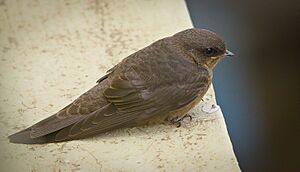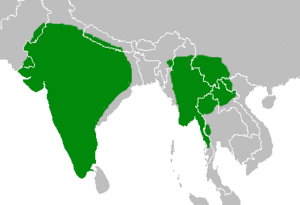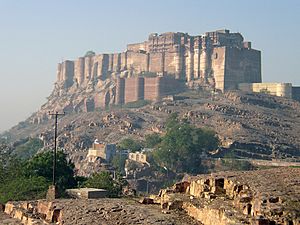Dusky crag martin facts for kids
Quick facts for kids Dusky crag martin |
|
|---|---|
 |
|
| At Purandar Fort, near Pune, India | |
| Conservation status | |
| Scientific classification | |
| Genus: |
Ptyonoprogne
|
| Species: |
concolor
|
 |
|
|
Approximate range
|
|
| Synonyms | |
|
Hirundo concolor |
|
The dusky crag martin is a small bird from the swallow family. It's about 13 cm (5 inches) long. It has a wide body, broad wings, and a short, square tail. This tail has small white spots near the tips of most feathers. The bird's upper body is a sooty-brown color. Its belly and chest are a bit lighter.
These birds live and breed in South Asia. You can find them from India to southwestern China. They also live in northern parts of Thailand, Vietnam, and Laos.
Dusky crag martins build their nests under cliff overhangs. They also use human-made buildings. Their nest is a neat half-cup shape made of mud. It's lined with soft materials. Both parent birds take turns sitting on the two to four eggs. They also both feed the young chicks. These birds don't form huge groups for breeding. But they are more social when it's not breeding season. They eat many different kinds of insects. They catch these insects while flying near cliffs. Bigger bats and birds of prey might hunt them. But there are many dusky crag martins. Their living area is also growing. So, they are not currently in danger.
Contents
About the Dusky Crag Martin
The dusky crag martin was first described in 1832. A British soldier and bird expert, William Henry Sykes, named it Hirundo concolor. Later, a German bird expert, Heinrich Gustav Reichenbach, moved it to a new group called Ptyonoprogne in 1850.
The name Ptyonoprogne comes from Greek words. Ptyon means "a fan," which describes the bird's tail when it's open. Procne is a name from an old story about a girl who became a swallow. The word concolor comes from Latin. It means "together" and "color." This refers to the bird's mostly plain color.
This bird is related to three other birds in the Ptyonoprogne group. These are the rock martin, the pale crag martin, and the Eurasian crag martin. All these birds are part of the swallow family.
What Does It Look Like?
The dusky crag martin is about 13 cm (5 inches) long. It has a wide body, wings, and tail. Its upper parts are a dark, sooty-brown. Its belly and chest are a bit lighter. The chin, throat, and front of the neck are pale and streaky.
Its tail is short and square. Most tail feathers have small white spots near the tips. The feathers under its wings are dark brown. Its eyes are brown, and its small beak is mostly black. Its legs are brownish-pink.
Male and female dusky crag martins look alike. Young birds have reddish-grey tips on their upper body and wing feathers. You can tell this bird apart from the Eurasian crag martin. The dusky crag martin has darker underparts. Its white tail spots are also much smaller.
This small bird usually flies slowly and easily. But it can fly very fast if it needs to. Its calls sound like the Eurasian crag martin. It makes a soft chi, chi sound to keep in touch. It also has a chirping song.
Where Do They Live?
The dusky crag martin lives and breeds in many parts of India. This includes areas from the Himalayas down to the Nilgiri mountains. It also lives east to West Bengal. Another group of these birds lives in southwestern China. They are also found in northern Thailand, Vietnam, and Laos.
These birds usually stay in the same area all year. They only move locally after breeding. They have bred in Malaysia at least once. They have also been seen in Sri Lanka and probably Borneo.
Their natural home is in hills or mountains. They like cliffs, deep valleys, and caves. They usually nest up to about 1,800 meters (5,900 feet) high. In Thailand, they can be found up to 2,000 meters (6,600 feet).
These martins also live in lower areas. They use human-made buildings instead of natural cliffs. Old stone forts are a favorite spot. You can even find dusky crag martins in cities like Mumbai. Nests on buildings can be 30 meters (98 feet) high. They sometimes build nests in unusual places, like on light fixtures.
How Do They Behave?
Nesting and Raising Young
Dusky crag martin pairs usually nest alone. But in good spots, several pairs might nest close to each other. They naturally nest under ledges on cliffs or river banks. But they easily use human-made buildings too. They prefer old stone buildings like hill forts, mosques, and tombs. They also use bridges, archways, and tunnels.
They can breed in any month. But they mostly breed in February and March. They breed again after the rains start in July and August. They usually raise two groups of young each year.
Both parents build the nest. It's an open, half-cup shape made of mud. They line it with soft things like feathers or dry grass. They build it under an overhang or in a crack on a cliff or building. They use the same nest for their second group of young. They also use it again in later years.
They lay two to four eggs. The eggs are white with reddish-brown spots. These spots are mostly on the wider end. Both parents sit on the eggs and feed the chicks. We don't know exactly how long it takes for the eggs to hatch or for the chicks to leave the nest. But it's probably similar to the Eurasian crag martin. That bird's eggs hatch in 13–17 days. The chicks leave the nest in 24–27 days.
What Do They Eat?
The dusky crag martin mainly eats insects. They catch these insects while flying. When they are nesting, they often fly back and forth near a rock face or building. This is how they hunt for food.
When it's not breeding season, these birds are more social. They might form small groups where there's a lot of food. They like to hunt near vertical surfaces. Studies show that cliffs create air currents. These currents gather insects near the cliff faces. The martin uses its great flying skills to catch insects close to the cliff. When feeding their young, they hunt mostly in areas very close to the nest. This is because flying shorter distances means they can feed their chicks more often.
Who Hunts Them?
Birds of prey like the peregrine falcon hunt these small martins. The greater false vampire bat has also been seen eating them.
How Are Their Numbers?
We don't know the exact number of dusky crag martins. But it seems their population is growing. This is because they can use human-made buildings for nesting. These birds are common in India, Thailand, and southern China. Their living area seems to be getting bigger. They are spreading northeast into Guangxi. They are also moving south into lowland Laos. And they are moving west to the hills and plains of Sindh. There was also a recent report from Cambodia, but it's not confirmed.
Because they live in a large area and have many birds, the dusky crag martin is not considered in danger. It is listed as Least Concern on the IUCN Red List.



